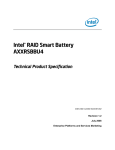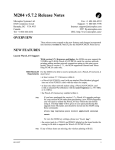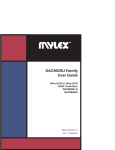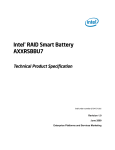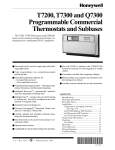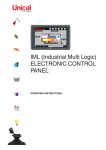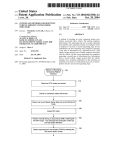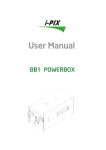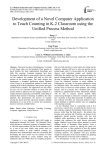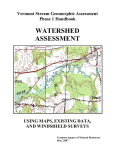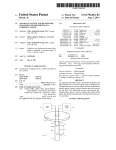Download < SYSTEM BUS v
Transcript
US006557077B1 (12) United States Patent (10) Patent No.: Ghosh et al. (54) US 6,557,077 B1 (45) Date of Patent: TRANSPORTABLE MEMORY APPARATUS AND ASSOCIATED METHODS OF 5,448,719 A 5,677,890 A INITIALIZING A COMPUTER SYSTEM 9/1995 Schultz et al. 10/1997 Liong et al. 2 , HAVING THE SAME , (75) Inventors: Sukha R. Ghosh, Lilburn, GA (US); Paresh Chatterjee, Fremont, CA (US); Stephen Scott Piper, McDonough, GA (US); Marc C, Karasek, Duluth, GA (US); Basavaraj Gurupadappa létlontg 6: ‘11* 5,982,899 A Apr. 29, 2003 aa s e a . 710/10 ................ .. * 11/1999 Probst ....................... .. 380/25 OTHER PUBLICATIONS User’s Manual, MyleX DBB960, Battery Backup Module, Version 1.0, 1994. Hallyal, Fremont, CA (US) * cited by examiner (73) Assignee: LSI Logic Corporation, Milpitas, CA (Us) (*) Notice: Primary Examiner—Tuan V. Thai (74) Attorney, Agent, or Firm—Carstens, Yee & Cahoon Subject to any disclaimer, the term of this patent is extended or adjusted under 35 U.S.C. 154(b) by 124 days. (57) ABSTRACT (21) Appl- NO? 09/ 612,054 A transportable memory apparatus including cache memory and a backup battery is provided that is capable of being (22) removed from a ?rst computer system and installed Within Filed Jul 7 2000 ' (51) ' ’ a second computer system. The transportable memory appa Int. Cl.7 .............................................. .. G06F 12/00 ratus includes a control bus that provides appropriate signals (52) __ 711/118; 711/100; 711/135 such that the presence and status of the transportable (58) Field of Search ....................... .. 713/1, 2; 711/135, memory apparatus can be detected in Order to Permit the 711/100, 103, 118, 154; 710/10 computer system that includes the transportable memory apparatus to be appropriately initialized. As such, methods (56) References Cited for initializing a computer system that may include a trans portable memory apparatus are also provided. U.S. PATENT DOCUMENTS 5,056,001 A * 10/1991 Sexton ...................... .. 710/10 15 Claims, 8 Drawing Sheets .,»"'"T < / SYSTEM BUS 16 NON VOLATILE MEMORY CZ? v 41 [fr/12 1‘ 23 l / [/21 _ _\‘\_ — T _ _ _ _ _ _ — _ _ T 7' BATTERY . l '/ MEMORY MEMORY BUS cPU STORAGE POWER MODULE CONTROL BUS VOLTAGE 2o COMPARATOR I MODULE I T I 11,1 \\ I | | POWER SOURCE SELECTION | MODULE l v l ' IT MEMORY |I | MODULE T | | 40, _|_ MODULE _ _ _ ~ _ \\ \22 /""*’14 10 , '/ TRANSPORTABLE MEMORY | ,,/' I l_ ‘\ _ _ _ _ _ - _ _ | _ _ 13 | 1/ 15 / SYSTEM POWER SUPPLY U.S. Patent Apr. 29, 2003 Sheet 2 0f 8 US 6,557,077 B1 U.S. Patent Apr. 29, 2003 Sheet 5 0f 8 US 6,557,077 B1 69 \\ 7° POWER UP POWER UP FROM SYSTEM FROM BBU 79 0 \\i v PFAIL = 1 PFAIL = 1 BBEN = o BBEN = 1 V" 71 SYSTEM POWER >= 4.7V 72 PFAIL = 0 73 v ‘\H SWITCH TO POWER FROM SYSTEM FIG. 5 SYSTEM POWER <= 4.6V 75 \ PFAIL = 1 \’ SWITCH TO POWER FROM BATTERY 80 V V \ POWER SYSTEM DOWN POWER IN BB MODE DOWN 7a U.S. Patent Apr. 29, 2003 Sheet 6 0f 8 US 6,557,077 B1 mm mm A OZ mm a wm>\ .QEm EMJOIPZU MXDOEZ mm mm OZ mm om ) U.S. Patent mw Apr. 29, 2003 Sheet 7 0f 8 US 6,557,077 B1 mm mo? T6301 ‘m Em02 k m; m; Ev mm mm on U.S. Patent l/ Apr. 29, 2003 Sheet 8 0f 8 US 6,557,077 B1 64 / v i '60 v / STOP _ ERROR DKC ‘ DRC? STOP ERROR RESTORE CONFIG IN NVRAM (NVC = DRC) 62 \ 4 V FLUSH CACHE (IF NEEDED) LEGEND NVC is configuration information stored in NVRAM 16 DRC is configuration information stored in Memory 40 DKC is configuration information stored on Memory Storage 12 ‘ i END FIG. 8 US 6,557,077 B1 1 2 TRANSPORTABLE MEMORY APPARATUS AND ASSOCIATED METHODS OF INITIALIZING A COMPUTER SYSTEM HAVING THE SAME only to the cache memory, instead of to both cache memory and the storage device. Therefore, the total time to Write data is only the time required to Write data to the cache memory. HoWever, the data Will only be Written from the cache memory to the non-volatile storage device When the cache memory is full or When activity on the controller is loW. Unfortunately, the Write-back cache method necessitates that FIELD OF THE INVENTION the storage device Will go through periods of not containing The present invention relates generally to computer that include cache memory and, more particularly, to a trans any neW or updated blocks of data With the neW or updated portable memory apparatus that includes cache memory and associated methods of initializing a computer having a blocks of data being, instead, maintained by the cache 10 memory. As such, if the poWer supply fails, then the neW blocks of data Will be lost and non-recoverable since the cache memory is volatile. This loss of data is particularly transportable memory apparatus. BACKGROUND OF THE INVENTION relatively safe and recoverable non-volatile storage device. problematic since the memory controller has previously sent an acknoWledgement to the operating system indicating that the data Was received by the storage device Without provid ing any indication that the data had only been stored in cache An eXample of a non-volatile storage device is a hard disk memory. Upon receiving the acknoWledgment, the operating Generally, computers or computer systems have associ ated devices for storing data. The data may be stored on a 15 drive. The techniques or procedures for storing data on system is no longer obligated to maintain the data and non-volatile storage devices are Well knoWn in the art. As the volume of data stored on non-volatile storage devices increases, hoWever, so does the concern for data integrity therefore cannot be relied upon to recover any data lost in cache memory. Cache memory therefore has a central ?aW. When poWer to the caching controller fails or is interrupted for any reason, the contents of the cache memory is generally lost or and reliability. When a ?le is Written to a hard disk drive, the operating system transfers the data in the ?le generally in sections 25 called blocks. A block of data is ?rst sent to a memory controller, such as an integrated device electronics (IDE) controller or a small computer standard interface (SCSI) overcome this problem. One such attempt to resolve this problem is to have a battery backup for the cache memory. One eXample of a conventional computer system 100 that includes a cache memory system 150 is depicted in FIG. 1. controller. After receiving the block of data, the controller sends an acknowledgement of receipt to the operating sys tem. Upon receiving this acknoWledgement, the operating system then considers the block to be safely stored in the storage device. The cache memory system 150 is poWered by the system poWer supply 130 and communicates With the computer system via system bus 115. The cache memory system In a controller Without cache memory, the memory con troller transfers the data immediately to the storage device before an acknoWledgement is sent back to the operating corrupted. As the siZe of cache memories increase, the potential for data loss also increases. Numerous techniques for data recovery and data storage have been developed to 35 includes cache memory 200, typically con?gured as a cache array, such as an Intel 21256 Dynamic Random Access system. Many higher-end controllers have cache memories. Memory (DRAM). The cache memory system also includes Cache memory is higher-speed memory that stores data that has recently been retrieved from or is in the process of being transferred to a non-volatile storage device, thereby saving time by not requiring that the non-volatile storage device be accessed if the data is needed again in the near future. A processing unit (CPU) 110 of the computer system and for generally controlling the operations of the cache memory system. As depicted in FIG. 1, the cache memory system a cache controller 160 for interacting With the central memory controller (also termed a caching controller) that is associated With a cache memory sends, an acknoWledge ment to the operating system after the data is stored in the cache memory Without Waiting for the data to be stored in a non-volatile storage device. Caching controllers generally employ one of tWo methods to handle data that has been Written to a storage device, Write-through cache and Write-back cache. A caching con 45 designed such that the battery unit provides poWer to the troller employing the ?rst method, Write-through cache, cache memory if the system poWer supply fails or if poWer to the cache memory is otherWise interrupted. As such, the Writes the block of data to tWo locations once the data is received, that is, the caching controller Writes the data to both the cache memory and to the storage device. Because the data is Written to cache memory, the data can be quickly accessed again if needed for later use. HoWever, the data is also simultaneously stored in a safe manner in the storage also includes a refresh unit 177 that periodically refreshes the contents of the cache memory and a battery unit 176 for providing auxiliary poWer to the cache memory. In order to control the manner in Which the cache memory is refreshed and the manner in Which auXiliary poWer is provided to the cache memory, the cache memory system can also include a selector 180 that operates under control of the cache controller 160. As such, the cache memory system can be cache memory system can retain the contents of the cache memory until such time that the poWer failure is recti?ed and 55 device. Unfortunately, the time that is required to Write the data from the operating system to the storage device accord ing to a Write-through cache method is greater than the time to Write data directly to a storage device Without passing through a caching controller. In fact, the total time to Write data according to the Write-through cache method is equal to the computer system can again be poWered on, thereby permitting the contents of the cache memory to be trans ferred to main memory 120, typically a non-volatile memory device, for storage. It is also advantageous for the cache memory 200 along With the associated battery and refresh units 176, 177 (collectively designated as 170 in FIG. 1) to be modular so as to be moved from one computer system and installed in the time to Write data to the cache memory plus the time to Write data to a storage device. 65 another computer system. As such, in instances in Which the cache controller 160 fails While the cache memory is dirty, the battery unit can supply auxiliary poWer to the cache The second method, Write-back cache, reduces the time requirements of the ?rst method by Writing the block of data While the modular cache memory and associated battery unit memory in order to retain the contents of the cache memory US 6,557,077 B1 3 4 are removed from the computer system that has experienced the failure and are installed in another computer system. Upon poWering up the neW computer system, the dirty data bus includes a battery backup enable channel for enabling the battery to provide auxiliary poWer, typically in instances in Which the cache memory is dirty. The control bus also can be ?ushed from the cache memory to main memory 120 such that no data is lost. As a result of the removal of the cache memory from a includes an identi?cation channel for providing an indica tion to the host controller that the transportable memory apparatus is present. The control bus can further include a battery backup mode channel for indicating if the battery is currently providing auxiliary poWer to the cache memory. As ?rst computer system and the installation of the cache memory in a second computer system, a number of problems arise in the manner in Which the second computer system is initialiZed so as to identify the neWly installed cache memory, to detect if the neWly installed cache memory has dirty data, and to appropriately ?ush the dirty data to a non-volatile storage device of a second computer system. If the cache memory is not identi?ed and the dirty data is not appropriately ?ushed, data may be lost or the integrity of the 10 such, the host processor can detect the presence of the transportable memory apparatus and can determine the status of the transportable memory apparatus, either upon initialiZation of the computer system or at any time there after. In this regard, a method for initialiZing a computer system is also provided that initially determines if a transportable 15 data may otherWise be compromised, notwithstanding memory module is present, such as by examining an iden ti?cation line of the control bus interconnecting the trans removal of the cache memory from the computer system that has experienced the failure and the installation of the cache memory in a different computer system. portable memory module With the computer system. If the transportable memory module is present, it is determined if SUMMARY OF THE INVENTION sistent. If the con?guration information stored by the trans portable memory module and the memory storage device are consistent, the data stored by the transportable memory module is ?ushed to the memory storage device. As such, the method of this aspect of the present invention permits the transportable memory module and the memory storage the con?guration information stored by the transportable memory module and the memory storage device are con A transportable memory apparatus including cache memory is provided that is capable of being removed from a ?rst computer system and installed Within a second com puter system. According to the present invention, the trans 25 portable memory apparatus includes a control bus that provides appropriate signals such that the presence and device, such as one or more disk drives, to be transported from a ?rst computer system to a second computer system, status of the transportable memory apparatus can be detected such as in the event of a system poWer failure or a hardWare in order to permit the computer system that includes the transportable memory apparatus to be appropriately initial iZed. As such, methods for initialiZing a computer system failure in the ?rst computer system, While still facilitating the ?ushing of dirty data from the transportable memory that may include a transportable memory apparatus are also second computer system. If the con?guration information stored by the transportable memory module and the memory module to the memory storage device once installed in the advantageously provided. According to one embodiment, a transportable memory storage device are inconsistent, hoWever, an error message is 35 apparatus capable of being relocated from a ?rst computer system to a second computer system is provided. The transportable memory apparatus includes cache memory for at least temporarily storing data transferred betWeen a host computer system. In this regard, the method determines if the transportable memory module has been transported processor and a memory storage device, such as a plurality of disk drives. The transportable memory apparatus also includes a battery for providing auxiliary poWer to the cache memory. The transportable memory apparatus further includes a poWer source selector for selectively providing poWer from either a system poWer supply or from the issued. The method of this embodiment to the present invention also determines if the transportable memory module has been transported from one computer system to another betWeen computer systems by comparing the con?guration 45 information stored by the transportable memory module and the con?guration information stored by the non-volatile memory device of the ?rst computer system. If the con?gu ration information stored by the transportable memory mod battery. Typically, the poWer source selector provides the cache memory With poWer from the system poWer supply. ule and a non-volatile memory device are different, it is HoWever, if the poWer source selector detects that the system poWer has fallen beloW a minimum system threshold, cache memory can be provided With auxiliary poWer from the transported betWeen computer systems. If, hoWever, the con?guration information stored by the transportable determined that the transportable memory module has been memory module and the non-volatile memory device match, it is determined that the transportable memory module has not been transported. If it is determined that the transport battery, especially in instances in Which the cache memory includes dirty data. In this regard, the transportable memory apparatus can able memory module has been transported from one com include a voltage comparator module that includes a ?rst comparator for comparing the system poWer to the minimum system threshold. If the voltage comparator determines that the system poWer has fallen beloW the minimum system threshold, the voltage comparator of this embodiment Will signal the poWer source selector. The voltage computer puter system to another computer system, and if the con 55 device is restored by copying the con?guration information of the transportable memory module to the non-volatile memory device. In addition, in embodiments in Which the memory storage device includes a plurality of disks, the consistency of the disks can be checked prior to determining if the con?gura module can also include a second comparator for comparing the auxiliary poWer provided by the battery to a minimum battery threshold and for signaling the poWer source selector if the auxiliary poWer does fall beloW the minimum battery threshold. The transportable memory apparatus of this embodiment also includes a control bus for interconnecting the transport able memory apparatus With the host processor. The control ?guration information stored by the transportable memory module and the memory storage device are consistent, the con?guration information of the non-volatile memory tion information stored by the transportable memory module 65 and the memory storage device are consistent. If the plural ity of disks are inconsistent, an appropriate error message can be issued. US 6,557,077 B1 5 6 According to another embodiment to the present invention, a method for initializing a computer system is provided in Which the memory controller is initialized in BRIEF DESCRIPTION OF THE DRAWINGS The invention is illustrated in the draWings in Which like reference characters designate the same or similar parts different manners depending upon the presence of a trans portable memory module or a more conventional cache throughout the ?gures of Which: FIG. 1 illustrates a block diagram of a transportable cache memory device. In this regard, the method initially deter mines if cache memory contains data that is dirty. If the cache memory contains data that is dirty, the method deter mines if a transportable memory module is present that includes the cache memory. Thereafter, the memory con memory system of the prior art, FIG. 2 illustrates a block diagram of a computer system including a transportable memory module according to one 10 troller is initialiZed With values identifying the siZe and type of the cache memory. At least in instances in Which the cache memory contains data that is dirty, the memory controller is initialiZed With values obtained from the cache memory if embodiment of the present invention, FIG. 3 illustrates a block diagram of a transportable memory module interfacing With a host computer system according to one embodiment of the present invention, FIG. 4 illustrates a more detailed block diagram vieW of able memory module is not present. Once the memory the transportable memory module of FIG. 3, FIG. 5 is a top-level ?oW chart illustrating operations performed to sWitch betWeen auxiliary poWer and system controller has been initialiZed, dirty data stored by the cache poWer, the transportable memory module is present and With values 15 obtained from a non-volatile memory device if a transport FIG. 6 is a How chart illustrating the operations performed memory can be ?ushed to the memory storage device. If, hoWever, cache memory does not contain data that is dirty, to initialiZe a computer system according to one embodi the cache memory can be examined to detect the siZe and ment of the present invention, type of the cache memory, Which values are subsequently utiliZed to initialiZe the memory controller. In order to provide auxiliary poWer to the cache memory, the computer system typically includes a battery. As such, FIG. 7 is a How chart illustrating the manner in Which a 25 cache memory may be determined to contain data that is dirty by examining the battery backup enable channel of the during the initialiZation of a computer system to determine if the cache memory and the memory storage device are control bus interconnecting the memory controller and the cache memory. If the battery backup enable channel indi cates that the battery is enabled, cache memory Will be determined to contain data that is dirty. In addition, a ?ag stored by the non-volatile memory device may be utiliZed to indicate that cache memory contains data that is dirty. As such, the ?ag stored by the non-volatile memory device may be examined to determine if the cache memory contains data ?ag is set during initialiZation operations to indicate that dirty data should be ?ushed from the cache memory accord ing to one embodiment of the present invention, and FIG. 8 is a How chart illustrating operations performed similarly con?gured before ?ushing the cache memory. DETAILED DESCRIPTION OF THE INVENTION The present invention noW Will be described more fully hereinafter With reference to the accompanying draWings, in 35 that is dirty. The transportable memory apparatus of the present inven Which preferred embodiments of the invention are shoWn. This invention may, hoWever, be embodied in many different forms and should not be construed as limited to the embodi ments set forth herein; rather, these embodiments are pro tion includes cache memory and a battery for providing auxiliary poWer to the cache memory such that the trans vided so that this disclosure Will be thorough and complete, and Will fully convey the scope of the invention to those portable memory apparatus can be moved from a ?rst skilled in the art. Like numbers refer to like elements computer system and installed in the second computer system Without losing or otherWise impairing the integrity of any data stored by the cache memory. The transportable memory apparatus is also designed to provide signals indica throughout. Referring noW to FIG. 2, a computer system 14 including a transportable memory apparatus 10 (TMA) according to tive of its presence and status to the host computer for use 45 one advantageous embodiment of the present invention is depicted. As described beloW, the computer system operates during initialiZation and the like. As such, methods for initialiZing the host computer are also provided that deter to provide cache memory, poWer source sWitching functions and memory recon?guration functions during the activation or poWering up of the computer system. For example, auxiliary poWer may be provided to the cache memory 40 in the event that the system poWer supply 15 should fail, mine the presence and status of a transportable memory apparatus and that ?ush any dirty data that has been stored by the cache memory of the transportable memory appara tus. In this regard, a method that insures the consistency of the con?guration information of the various memory devices prior to ?ushing the dirty data is provided. In addition, a method of initialiZing the memory controller of a host computer system With values identifying the siZe and type of thereby preserving the integrity of the data stored by the cache memory. If the poWer failure results from a disruption in the system poWer supply, the stored data may be doWn 55 loaded to a memory storage device 12, such as one or more the cache memory is provided that determines if a trans disk drives, during the next activation or poWer up sequence portable memory module is present and then initialiZes the memory controller With values identifying the siZe and type of the computer system after the disruption in the system poWer supply is remedied. Alternatively, if the poWer failure resulted from a failure Within the computer system itself, of a cache memory in different manners depending upon the presence or absence of a transportable memory module. As such as a hardWare failure, the TMA including the cache memory may be transported to another computer system. such, the transportable memory apparatus and associated methods of the present invention provide for the storage and recovery of dirty data in instances in Which the system The memory storage device may also be connected to the other computer system such that the data stored by the cache memory may be doWnloaded to the memory storage device poWer falls beloW a predetermined minimum level or the host computer suffers some type of hardWare failure requir ing that the cache memory be transported to another com puter for recovery of the dirty data. 65 upon activating or poWering up the other computer system. Referring in more detail to FIG. 2, the TMA 10 is shoWn to be connected to and in communication With a host US 6,557,077 B1 7 8 computer system 14. The host computer system includes a one embodiment is comprised of discrete logic that senses central processing unit (CPU) 41. The host computer system both the system poWer level and the battery poWer level, and provides the poWer source selector With comparison data. As may also, if desired, comprise an internal or external memory storage device 12, a poWer supply 15, and a system bus 13 that connects the CPU 41 to the memory storage device 12. The host computer system may, if desired, be any computer system or controller that utiliZes memory storage as discussed herein. An example of a host computer system is a DELL PoWeredge 6300 computer system. The memory storage device may, if desired, be one or more memory disk drives used to store data or information. An example of a Will be apparent, hoWever, both the poWer source selector and voltage comparator can be embodied in other manners, if so desired. LikeWise, a variety of different batteries can be employed, although one example of a typical battery is a Promark battery bearing part number BAT-NIMH-4.8-01. 10 typical memory disk drive is a Seagate Cheetah disk drive. The TMA 10 is typically connected to the host computer channels for transmitting analog or, more typically, digital signals, either synchronously or asynchronously. The control bus can interconnect the TMA and the CPU 41 either system 14 via an adapter slot or some other type of expan sion slot. HoWever, the transportable memory module can be connected to the host computer system in other manners, if so desired. As its name suggests, hoWever, the transportable memory module is transportable and may, if desired, be removed from the host computer system and installed in another computer system (not shoWn). Once the TMA is installed in the other computer system, the TMA is designed 15 The control bus 22 of the illustrated embodiment includes 20 memory. If desired, a standard cache memory module (not shoWn) may be substituted in the host computer system in 30 computer system via an interface bus 24, as shoWn in FIG. 3 The interface bus 24 may be a card edge connector having either its male or female connection attached to the host computer system 14 and its mating connection attached to the TMA. The interface bus provides the user With the option provided by the TMA to the host computer system. BBEN is logically set by the host computer system to enable the battery backup function of the TMA. For example, BBEN is typically set if cache memory 40 contains dirty data to prevent the dirty data from being lost in the event of a system poWer failure. Conversely, if BBEN is logically reset by the host computer system, the battery backup function is dis abled. The setting or resetting of BBEN may be at any convenient time or pulse duration. HoWever, BBEN is typically set by the host computer system When data is stored 35 of inserting the TMA or inserting a standard cache memory module. Either the TMA 10 or a standard cache memory module Will provide the host computer system 14 With memory to store information or data during typical caching operations. Caching of data is a Well knoWn procedure of temporarily storing data or information in a special memory subsystem in Which frequently referenced data values are duplicated for four data channels, namely, a battery backup enable channel 30 (BBEN) and a battery backup strobe channel 31 (BBSTROBE) that permit the host computer system 14 to provide signals to the TMA 10 and a battery backup mode channel 32 (BBMODE) and a TMA channel 29 that are 25 be able to detect if the TMA is present or if a standard cache memory module is present, as described beloW. As shoWn in FIG. 2, the TMA 10 can communicate With the CPU 41 via a memory bus 21 and a control bus 22. If desired, hoWever, the TMA may communicate With the host directly or indirectly. For example, the control bus may directly interconnect the TMA and the CPU as depicted in FIG. 2 or the control bus may communicate With the CPU via an interface bus as shoWn in FIGS. 3 and 4. to continue to function Without loss of data stored in its place of the TMA, although the host computer system Will As shoWn in FIG. 4, the TMA 10 is in bi-directional communications With the host computer system 14 via a control bus 22 having a plurality of information or data 40 to the cache memory. BBSTROBE is a stimulus from the CPU 41 to the TMA. BBSTROBE acts as a clocking signal from the host computer system to the TMA to cause BBEN to be read or latched. With respect to the signals provided by the TMA 10 to the host computer system 14, BBMODE 32 provides an indi cation as to Whether the TMA is actually operating in a battery backup mode of operation or, alternatively, Whether BBEN on the TMA is set or reset. For example, the pin to Which the TMA channel is connected can also be connected quently accessed memory locations and the addresses Where 45 via a pull-up resistor to system poWer or some other prede these data items are otherWise stored in main memory, i.e., termined voltage. As such, in the absence of a TMA, such as in instances in Which a conventional cache memory module Within the memory storage device 12. When the CPU 41 references an address in memory, the cache memory is ?rst is installed, the pin to Which the TMA channel Would checked to determine Whether the data stored at that address otherWise have been connected Will have a predetermined is stored in cache memory. If cache memory contains the voltage level, thereby indicating that a TMA is not present. quick access. A cache memory stores the contents of fre data requested by the CPU, cache memory returns the data to the CPU 41. If cache memory does not contain the data requested by the CPU, a regular memory access occurs. Typical caching functions or operations are delineated in “Computer OrganiZation and Architecture,” by William Stallings (1990); and “The Indispensible PC HardWare 55 mine if a TMA is present and, if so, the current mode of Book,” by Hans-Peter Messmer, Addison-Wesley (1997). As depicted in FIGS. 2 and 3, the TMA 10 includes cache memory 40, a poWer source selector 20, a voltage compara tor 19, and a battery 23. As illustrated, these elements are Upon connecting a TMA to the host computer system, such as to the interface bus 24, hoWever, the TMA Will tie the TMA channel to ground, thereby providing an indication that a TMA is present. As such, by examining the TMA and BBMODE channels, the host computer system can deter 60 generally separate modules, but can be con?gured in other operation of the TMA. In addition to the enablement of the battery backup mode of operation provided by BBEN 30, the poWer source selector 20 relies upon input from the voltage computer 19. As shoWn in FIG. 4, the voltage comparator includes a ?rst fashions, if so desired. In one embodiment, the poWer source comparator 19a for comparing the system poWer to a selector is comprised of discrete logic that receives infor predetermined minimum system threshold 34. If the system poWer drops beloW the predetermined minimum system threshold, the ?rst comparator provides a signal, designated mation on the state of the system poWer supply 15 and sWitches cache memory 40 betWeen system poWer and auxiliary poWer provided by the battery 23 When the system poWer supply fails. LikeWise, the voltage comparator 19 of 65 PFAIL, to the poWer source selector and to the interface bus 24. Similarly, the voltage comparator includes a second US 6,557,077 B1 9 10 comparator 19b for comparing the auxiliary poWer provided by the battery 23 to a predetermined minimum battery threshold 34 and for providing a signal 37, designated BADV3, if the auxiliary poWer falls beloW the predeter contains dirty data, the TMA 10 can maintain the integrity of the data in instances in Which the system poWer fails or the computer system has some other type of failure. As such, upon receiving an indication that system poWer has failed as mined minimum battery threshold. Based upon these inputs indicated by PFAIL being set to 1 as depicted in box 75, the poWer source selector detects if the battery backup mode has as Well as BBEN, the poWer source selector provides the cache memory With system poWer or, in the event that system poWer fails or is otherWise unavailable, With auxil iary poWer from the battery. In the rare event that neither system poWer nor auxiliary poWer is available, the computer system Will immediately initiate a poWer off sequence in been enabled by determining if BBEN=1. If battery backup mode has not been enabled, thereby indicating that cache memory does not include dirty data, the computer system 10 can be poWered doWn under the remaining system poWer as indicated in block 80. If, hoWever, battery backup mode is enabled indicating that cache memory contains dirty data, order to avoid damaging the battery. In this regard, FIG. 5 depicts logic implemented by the the poWer source selector sWitches the source of poWer to poWer source selector 20. As shoWn, the host computer system 14 can be poWered up in tWo different scenarios. In the cache memory from system poWer to the auxiliary poWer provided by the battery 23 as indicated in block 77 and then 15 the ?rst scenario, the computer system is poWered doWn While operating under system poWer and is then subse subsequently shuts doWn the computer system in battery backup mode as indicated in block 78. As described above, the TMA 10 can be removed from a ?rst computer system and installed in a second computer system. For example, in instances in Which the ?rst com quently activated or poWered up at some time later as depicted in block 68. In the other scenario, the computer system is poWered doWn While operating in battery backup mode With the auxiliary poWer being provided by the battery puter system fails While the cache memory 40 contains dirty data, the TMA and the memory storage device 12, such as 23 and is then poWered up at some later time as depicted in block 69. In either instance, system poWer Will initially be less than the predetermined minimum system threshold 34 one or more disk drives, can be installed or connected to a second computer system such that the dirty data can be since the system poWer Will need some time to ramp up to 25 doWnloaded to the memory storage device, thereby main taining the integrity of the data. With the transportability of the desired level, such as 5 volts. In instances in Which the computer system is being poWered up after being previously the TMA, hoWever, the computer system 14 must be espe poWered doWn While operating under system poWer, the battery backup mode is generally not enabled as indicated by cially designed to detect the presence of a TMA and to distinguish a conventional cache memory module, and to BBEN=0 in block 70. Conversely, in instances in Which the appropriately con?gure the computer system depending computer system is being poWered up after previously being poWered doWn While operating in battery backup mode, the upon the type of cache memory that is available. For example, the CPU 41 generally includes or is otherWise associated With a memory controller for controlling the manner in Which the memory storage device, cache memory and other memory devices are accessed. During the initial iZation process, the memory controller must therefore be battery backup mode Will be enabled as indicated by BBEN=1 in block 79. In either instance, the voltage comparator 19 compares the system poWer to the predetermined minimum system thresh old 34. As depicted in block 71 of FIG. 5, for example, the predetermined minimum system threshold can be 4.7 volts. Once the system poWer equals or exceeds the predetermined 35 provided With information relating to the type and siZe of each memory device, including cache memory. In order to illustrate the process by Which a computer system that may include a TMA according to the present invention is poW ered up and initialiZed, reference is noW made to FIG. 6. While the process depicted in FIG. 6 can be implemented in a number of different manners, the computer system 14 of minimum system threshold, the PFAIL signal provided by the voltage comparator can be reset as depicted in block 72 Which, in turn, triggers the poWer source selector 20 to provide system poWer to the cache memory 40 as opposed to auxiliary poWer from the battery 23 as depicted in block 73. one embodiment includes a non-volatile memory device 16 45 for storing a module of code or softWare that is called by the During operation of the computer system 14, the voltage CPU 41 upon poWering up of the computer system that comparator 19 continues to compare the system poWer to a de?nes the process of FIG. 6 as hereinafter described. As predetermined minimum system threshold 34. While the such, While the CPU Will be described as performing many of the steps of the process of FIG. 6, the CPU is typically operating under control of a softWare module stored by the voltage comparator can compare the system poWer to the same predetermined minimum system threshold both during initialiZation or poWering up of the computer system and non-volatile memory device or elseWhere. subsequently during operation of the computer system, the voltage comparator can be con?gured such that system poWer is compared to a slightly loWer minimum operational threshold during operation of the computer system. As depicted in block 74 of FIG. 5, for example, the voltage As shoWn in block 82, the various peripheral devices, serial ports and the advanced con?guration and poWer 55 controller, that controls the reading and Writing of data to and from the memory storage device 12 is appropriately con?gured. Thereafter, the CPU 41 reads data from the comparator can compare the system poWer to a predeter mined minimum operational threshold of 4.6 volts. If the system poWer falls beloW this predetermined minimum cache memory 40 that de?nes the siZe of memory, the type of memory, the number of banks and the like. See block 85. operational threshold, the voltage comparator Will again set Typically, this data is termed Serial Presence Defect (SPD) data. Thereafter, the CPU determines if battery backup has been enabled and/or if cache memory contains dirty data. See block 87. For example, the CPU typically examines the PFAIL to 1 as shoWn in block 75. Once PFAIL is set, the poWer source selector 20 Will determine if the battery backup mode is enabled. As described above, the battery backup mode is typically enabled in instances in Which cache memory 40 contains data that has not yet been stored or transferred to the memory storage device 12. By enabling the battery backup in instances in Which the cache memory interface (ACPI) are con?gured in a conventional manner. For example, the data control mechanism, such as a SCSI 65 BBEN channel of the control bus 22 to determine if the battery backup mode has been enabled. In addition, the CPU generally checks a ?ag that is maintained by the non-volatile US 6,557,077 B1 11 12 memory device 16 that is set in instances in Which the cache In order to appropriately ?ush any dirty data from cache memory 40 to the memory storage device 12, the computer system 14 generally performs several additional tests as memory contains dirty data. If the BBEN channel and/or the ?ag maintained by the non-volatile memory indicate that the battery backup mode has been enabled and that the cache memory contains dirty data, the CPU sets another ?ag, designated GFLAG. See block 91. Alternatively, if the battery backup mode has not been enabled and the ?ag maintained by the non-volatile memory does not indicate that cache memory includes dirty data, the CPU clears GFLAG. See block 90. Thereafter, the CPU 41 initialiZes the memory refresh controller. See block 92. Although not discussed in detail herein, the computer system 14 also includes a memory refresh controller and associated circuitry for periodically refreshing the data stored by the cache memory 40 to further preserve the integrity of the stored data. As knoWn to those skilled in the art, in instances in Which the computer system is being poWered up or initialiZed While the cache memory contains dirty data, the data stored by cache memory should shoWn in FIG. 7 to ensure that only valid data Will be ?ushed. While these tests can be performed folloWing the initialiZation process depicted in FIG. 6, these tests can also be performed during or concurrent With the initialiZation process, if so desired. While the process depicted in FIG. 7 can be implemented in a number of different manners, the 10 41 upon poWering up of the computer system that de?nes the process of FIG. 7 as hereinafter described. As such, While the CPU Will be described as performing many of the steps 15 As depicted in FIG. 7, these tests generally commence by determining if a TMA 10 is present in the same fashion as described above in conjunction With block 94 in FIG. 6. See block 45. If the TMA is present, the CPU 41 determines if battery backup circuitry is present, as shoWn in block 49. As generally understood, the battery backup circuitry is cir cuitry that is off-board from the TMA and that permits 25 is present for purposes of the process of FIG. 7, hoWever, battery backup circuitry Will only be considered to be present if both a battery 23 and the conventional battery shoWn in block 98. Although not depicted in FIG. 6, the siZe, backup circuitry are present. If the battery backup circuitry type and other information determined during an examina tion of cache memory may be compared to the SPD data and is present, the CPU determines if battery backup has been enabled by examining the BBMODE channel of the control bus 22. See block 50. If the battery backup mode has been an error message can be generated if there are signi?cant 35 and stored in the non-volatile storage medium 16, With a predetermined value designated TMD. See block 51. By setting this ?ag to TMD, the ?ag indicates that a TMA has 45 been detected that includes a cache memory With dirty data that can be ?ushed. If the battery backup mode has not been enabled, the CaniFlush ?ag Will be set, not to TMD, but to Invalid since no dirty data Was present in the cache memory at the time that the computer system Was previously poW ered doWn or since the battery Was disconnected during the prior poWer off sequence. See block 108. In instances in Which the battery backup circuitry is not present, the CPU 41 still determines if the cache memory 40 contains dirty data, such as by examining a dirty cache ?ag set in the non-volatile memory device 16 in instances in Which the cache memory contains dirty data. See block 110. TMA is not detected and a conventional cache memory module is, instead, installed, the memory controller is ini tialiZed With data, typically de?ning the siZe, type and other characteristics of cache memory, that has been previously stored in the non-volatile memory device 16, since Whatever SPD data that is collected from the conventional cache memory module may not be reliable. See block 96. enabled such as in instances in Which the system poWer has been shut doWn While the cache memory 40 contains dirty data, the CPU sets a ?ag, typically designated CaniFlush or, alternatively, Whether a conventional cache memory module is present. See block 94. In this regard, the CPU examines the TMA channel 29 of the control bus 22. In instances in Which the TMA channel is grounded, the CPU Will determine that a TMA is present. Conversely, in instances in Which the TMA channel is high, the CPU Will determine that the TMA is not present and a conventional cache memory module is, instead, installed. If the TMA is detected, the memory controller is initialiZed With the SPD data previously read from the cache memory since the SPD data is considered reliable. See block 95. If, hoWever, the auxiliary poWer to be provided to a conventional cache memory module. In determining if battery backup circuitry and other information relating to the cache memory, as differences therebetWeen. In instances in Which the GFLAG is set indicating that the battery backup mode is enabled and that the cache memory contains dirty data, the CPU Will not be able to actually examine the cache memory itself since the examination process may destroy some of the dirty data. As such, the CPU initially determines if a TMA 10 is present of the process of FIG. 7, the CPU is typically operating under control of a softWare module stored by the non volatile memory device or elseWhere. be refreshed sooner than instances in Which cache memory does not include dirty data. If the GFLAG has not been set indicating that the cache memory 40 does not contain dirty data and that battery backup mode has not been enabled, the CPU 41 actually examines the cache memory to determine its siZe, type and other related information. See blocks 93 and 97. The memory controller can then be initialiZed With the siZe, type non-volatile memory device 16 of one embodiment can also store a module of code or softWare that is called by the CPU If the dirty cache ?ag is set, the CPU sets the CaniFlush ?ag to Valid since the cache memory 40 contains dirty data that can be ?ushed to the memory storage device 12. See block 55 112. For example, the computer system may have undergone a Warm boot, i.e., the user simultaneously depresses the Thereafter, the CPU initialiZes the ECC registers maintained by the memory controller to enable error checking and CTRL, ALT and DEL keys, during a data transfer. If, hoWever, the dirty cache ?ag is not set, the CPU sets the correction. See block 99. The CPU then veri?es that the CaniFlush ?ag to Invalid since the cache memory does not include dirty data. See block 108. If the CPU 41 initially determines that the TMA 10 is not present, the CPU also determines if the dirty cache ?ag is set as shoWn in block 46. If the dirty cache ?ag has not been set, the CPU sets the CaniFlush ?ag to Invalid since no dirty formWare images in it internal read only memory (ROM) are correct and continues With the initialiZation process. See block 100. During this initialiZation process, dirty data maintained by the cache memory Will be ?ushed to the memory storage device 12 once the various memory devices, including the cache memory, the memory storage device and the non-volatile memory device, are determined to be consistent as described in detail below. 65 data remained in cache memory 40 at the time of the previous poWer doWn sequence. See block 48. If, hoWever, the dirty cache ?ag has been set, the CPU determines if the US 6,557,077 B1 13 14 battery backup circuitry is present as shown in block 47. If the battery backup circuitry is not present, the CPU sets the CaniFlush ?ag to Valid since the computer system has undergone a Warm boot during data transfer and dirty data regard, the CPU examines the CaniFlush ?ag and if the CaniFlush ?ag is set to Valid or to TMD, the CPU institutes a transfer of the dirty data from cache memory to the memory storage device. If the con?guration information for the cache memory 40 stored by the cache memory needs to be ?ushed to the memory storage device 12. See block 106. If the CPU and the memory storage device 12 are not the same, hoWever, the CPU 41 can issue an error message as depicted in block 60. In this regard, a user may determine that a determines that battery backup circuitry is present, hoWever, the CPU determines if the battery backup mode has been enabled by examining the BBMODE channel. See block 53. If the battery backup mode has not been enabled, the CPU sets the CaniFlush ?ag to Invalid since the battery 23 Was apparently disconnected at some point during the poWer doWn sequence and all data has already been lost. See block 54. If, hoWever, the battery backup mode has been enabled, the CPU determines if the PFAIL signal provided by the different set of disk drives has been connected to the 10 the memory devices Will then match and permit the dirty 15 voltage comparator 19 indicating a failure of system poWer has been asserted. See block 55. If PFAIL is asserted, the CPU sets the CaniFlush ?ag to Error since any data stored by the cache memory may be invalid, due to poWer broWn outs or the like. See block 57. If the PFAIL signal is not data from the cache memory to be transferred to the prior set of disk drives. Alternatively, if the initial test set forth in block 58 determines that the con?guration information for the cache memory 40 does not match the con?guration information for the non-volatile memory device 16, the CPU 41 Will deter mine that the TMA 10 has been moved from a ?rst computer system to a second computer system folloWing the poWering doWn of the ?rst computer system and prior to the poWering up of the second computer system. The CPU Will then asserted, hoWever, the CPU sets the CaniFlush ?ag to Valid to permit subsequent ?ushing of the dirty data maintained by the cache memory since system poWer Was apparently shut doWn during a prior data transfer. See block 56. By setting or resetting the CaniFlush ?ag as described computer system 14 since the last time that the computer system Was operated. As such, the user can reinstall the prior set of disk drives such that the con?guration information for examine the memory storage device 12 in the same manner 25 as described in conjunction With block 59. In particular, in instances in Which the memory storage device includes a above, the CPU 41 appropriately initialiZes the computer system 14 including the TMA 10 such that dirty data stored plurality of disk drives, the CPU determines if the disk drives are consistent. See block 63. If the plurality of disk by the cache memory 40 Will be ?ushed to the memory storage device 12, if the CaniFlush ?ag is set either to Valid or TMD, thereby protecting the integrity of the data. Prior to drives are not consistent, the CPU again issues an error message. See block 64. If, hoWever, the plurality of disk drives are consistent, the CPU determines if the con?gura ?ushing the dirty data to the memory storage device, hoWever, the computer system preferably ensures that the memory devices, including the cache memory, the memory tion information of the cache memory and the memory storage device match. See block 65. If the con?guration information of the cache memory and the memory storage storage device and the non-volatile storage device 16, are all con?gured in a consistent manner. In this regard, a process 35 device match, such as in instances in Which both the TMA and the memory storage device, such as a plurality of disk implemented by the computer system for ensuring that the drives, are removed from a ?rst computer system and memory devices are consistently con?gured is depicted in installed on a second computer system, the CPU restores the FIG. 8 and is typically performed folloWing the initialiZation con?guration information in the non-volatile memory device 16. See block 66. In particular, the CPU copies the con?guration information stored by the cache memory or by the memory storage device, to the non-volatile memory routine depicted in FIG. 6. As depicted in block 58 of FIG. 8, the CPU 41 initially determines if the TMA has been moved from one computer system to another. In this regard, the CPU obtains the con?guration information from the cache memory 40 and from the non-volatile storage device 16 for comparison purposes. Typically, this con?guration information de?nes device such that all memory devices noW have consistent con?guration information. Thereafter, the dirty data can be 45 ?ushed from the cache memory to the memory storage the manner in Which the memory array is constructed. If the device, if necessary. See block 62. If, hoWever, the con?gu CPU determines that the con?guration information stored by ration information of the cache memory does not match the the cache memory and by the non-volatile storage device are the same, the CPU determines that the TMA has not been moved. The CPU then examines the memory storage device 12. In embodiments in Which the memory storage device is con?guration information of the memory storage device, the comprised of a plurality of disk drives, the CPU next determines if the disk drives are consistent by comparing the con?guration of information stored by each disk drive. See block 59. If the plurality of disk drives are not consistent, the CPU again issues an error message. See block 64. By appropriately determining that the memory devices are similarly con?gured prior to attempting to ?ush any dirty data, the computer system 14 of the present invention 55 ensures that the dirty data is properly ?ushed from the cache memory 40 to a memory storage device 12, thereby pre venting loss of the data or any impairment of the integrity of the data. In addition, by implementing the process described above and depicted in FIG. 8, the computer system permits CPU issues an error message. See block 60. If the plurality of disks are consistent, hoWever, the CPU compares the con?guration information of the cache memory and the memory storage device. See block 61. If the con?guration the TMA 10 to be moved along With the memory storage device 12, such as a plurality of disk drives, from one computer system to another computer system, such as in information is the same, the CPU can determine that the same transportable memory apparatus and the same memory instances in Which the system poWer of the ?rst computer storage device Were previously connected to the computer system fails or the ?rst computer system suffers some other system during its most recent period of operation, i.e., prior type of hardWare problem. As such, the dirty data can be to the last time that the computer system Was poWered doWn. Since the memory devices are appropriately con?gured, the CPU can then ?ush dirty data from the cache memory to the memory storage device, if necessary. See block 66. In this 65 retrieved in a reliable and repeatable fashion. Many modi?cations and other embodiments of the inven tion Will come to mind to one skilled in the art to Which this invention pertains having the bene?t of the teachings pre US 6,557,077 B1 15 16 sented in the foregoing descriptions and the associated drawings. Therefore, it is to be understood that the invention connecting a transportable memory module With the ?rst computer system Which provides an indication that the is not to be limited to the speci?c embodiments disclosed and that modi?cations and other embodiments are intended to be included Within the scope of the appended claims. transportable memory module is present. 8. An apparatus for initialiZing a ?rst computer system Although speci?c terms are employed herein, they are used the method comprising: that includes a host processor and a memory storage device, in a generic and descriptive sense only and not for purposes of limitation. That Which is claimed: 1. A method for initialiZing a ?rst computer system that includes a host processor and a memory storage device, the ?rst determination means for determining if a transport able memory module is present; second determination means for determining if con?gu ration information stored by the transportable memory module and the memory storage device are consistent if a transportable memory module is present; and method comprising: determining if a transportable memory module is present; if a transportable memory module is present, determining if con?guration information stored by the transportable 15 memory module and the memory storage device are ?ushing means for ?ushing any dirty data stored by the transportable memory module if the con?guration information stored by the transportable memory mod ule and the memory storage device are consistent; consistent; and ?ushing any dirty data stored by the transportable Wherein the dirty data comprises unWritten cache data. 9. An apparatus according to claim 8 further comprising memory module if the con?guration information stored by the transportable memory module and the memory third determination means for determination means for storage device are consistent; Wherein the dirty data comprises unWritten cache data. transported from a second computer system to the ?rst computer system if a transportable memory module is 2. Amethod according to claim 1 further comprising, if a present. transportable memory module is present, the step of deter mining if the transportable memory module has been trans ported from a second computer system to the ?rst computer determining if the transportable memory module has been 25 prises: system. means for comparing con?guration information stored by the transportable memory module and the non-volatile memory device; means for determining that the transportable memory module has been transported if the con?guration infor mation stored by the transportable memory module and 3. A method according to claim 2, Wherein the ?rst computer system also includes a non-volatile memory device, and Wherein determining if the transportable memory module has been transported from a second com puter system to the ?rst computer system comprises: comparing con?guration information stored by the trans portable memory module and the non-volatile memory 35 device; the non-volatile memory device are different; and means for determining that the transportable memory module has not been transported if the con?guration information stored by the transportable memory mod ule and the non-volatile memory device match. 11. An apparatus according to claim 10 further comprising restoration means for restoring the con?guration informa tion of the non-volatile memory device by copying the con?guration information of the transportable memory mod ule to the non-volatile memory device if the transportable determining that the transportable memory module has been transported if the con?guration information stored by the transportable memory module and the non volatile memory device are different; and determining that the transportable memory module has not been transported if the con?guration information stored by the transportable memory module and the non-volatile memory device match. 4. A method according to claim 3 further comprising, if the transportable memory module has been transported from a second computer system to the ?rst computer system and 10. An apparatus according to claim 9, Wherein the ?rst computer system also includes a non-volatile memory device, and Wherein the third determination means com 45 memory module has been transported from a second com puter system to the ?rst computer system and if the con ?guration information stored by the transportable memory if the con?guration information stored by the transportable module and the memory storage device are consistent. memory module and the memory storage device are 12. An apparatus according to claim 11 Wherein the memory storage device comprises a plurality of disks, and Wherein the method further comprises: means for checking consistency of the plurality of disks prior to determining if the con?guration information stored by the transportable memory module and the consistent, restoring the con?guration information of the non-volatile memory device by copying the con?guration information of the transportable memory module to the non-volatile memory device. 5. A method according to claim 4 Wherein the memory storage device comprises a plurality of disks, and Wherein the method further comprises checking consistency of the plurality of disks prior to determining if the con?guration information stored by the transportable memory module and 55 memory storage device are consistent; and means for issuing an error message if the plurality of disks are inconsistent. 13. An apparatus according to claim 8 further comprising issuing an error message if the con?guration information the memory storage device are consistent and issuing an error message if the plurality of disks are inconsistent. stored by the transportable memory module and the memory 6. A method according to claim 1 further comprising storage device are inconsistent. issuing an error message if the con?guration information 14. An apparatus according to claim 8 Wherein the ?rst stored by the transportable memory module and the memory determination means comprises means for examining an identi?cation channel of a control bus interconnecting a storage device are inconsistent. 7. Amethod according to claim 1 Wherein determining the presence of the transportable memory module comprises eXamining an identi?cation channel of a control bus inter 65 transportable memory module With the ?rst computer sys tem Which provides an indication that the transportable memory module is present. US 6,557,077 B1 17 18 15. A computer program product, in a computer readable medium, for initializing a ?rst computer system that memory storage device are consistent if a transportable includes a host processor and a memory storage device, the instructions for ?ushing any dirty data stored by the transportable memory module if the con?guration information stored by the transportable memory mod method comprising: instructions for determining if a transportable memory module is present; instructions for determining if con?guration information stored by the transportable memory module and the memory module is present; and ule and the memory storage device are consistent; Wherein the dirty data comprises unWritten cache data. * * * * *



















